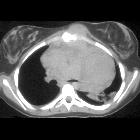Lymphomatous involvement of the breast








Breast lymphoma refers to the involvement of the breast with lymphoma and may be primary or secondary.
Epidemiology
Both primary and secondary breast lymphomas are rare. Breast lymphoma accounts for <1% of all breast malignancies and <2% of all extranodal non-Hodgkin lymphoma . Secondary lymphoma is the most common type of secondary malignancy/metastasis involving the breast (17%) .
Secondary breast lymphoma more common than primary lymphoma .
The median age of presentation is 60-70 years .
Clinical presentation
Breast lymphoma may present either as a palpable mass or as diffuse thickening of the breast. Axillary lymph nodes are enlarged in a substantial minority .
Pathology
Primary breast lymphoma
Primary breast lymphoma is typically a B cell type of non-Hodgkin lymphoma (NHL), with the most common histologic type being diffuse large B cell lymphoma . A minority of cases are follicular lymphoma, mucosa-associated lymphoid tissue lymphoma, or Burkitt lymphoma . A rare subtype associated with breast implants is anaplastic large cell lymphoma.
For a tumor to be labeled as a primary breast lymphoma, it must fulfill the following criteria :
- the disease should be in the breast or in close proximity to breast tissue
- no previous history of extramammary lymphoma
- no evidence of widespread disease, except ipsilateral axillary lymph nodes may be involved if developing simultaneously with primary breast tumor
Secondary breast lymphoma
Secondary lymphoma of the breast is also more frequently non-Hodgkin lymphoma than Hodgkin lymphoma.
Radiographic features
There is no single imaging finding diagnostic of lymphoma. A biopsy is typically required for diagnosis. Enlarged intramammary lymph nodes may be seen, but these can be seen also in other breast malignancies.
Mammography
Breast lymphoma most commonly appears as a solitary mass, and less commonly as an asymmetry . Calcifications are absent . The particular mammographic features of lymphoma presenting as a breast mass are nonspecific: it is usually oval or round in shape, with circumscribed or indistinct margins. Less common features are skin thickening and lymphedema manifest as a diffuse increase in parenchymal density.
Ultrasound
Breast lymphoma most commonly appears as a hypoechoic mass. The particular sonographic features are nonspecific: shape can be oval or irregular, margins can be circumscribed or indistinct, and orientation is usually parallel . Lymphomas are usually hypervascular .
MRI
- T1 C+:
- mass with homogeneous or heterogeneous enhancement
- enhancement curve usually type II or less commonly type III
- skin thickening associated with diffuse infiltration in a minority of cases
Differential diagnosis
Both radiologic and clinical appearances are similar to carcinoma and therefore the differential diagnosis is difficult. Mammographic findings are nonspecific and the following should be considered :
- primary epithelial breast cancer
- fibroadenoma
- phyllodes tumor
- metastases to the breast
Siehe auch:
und weiter:

 Assoziationen und Differentialdiagnosen zu Lymphom der Mamma:
Assoziationen und Differentialdiagnosen zu Lymphom der Mamma:



